-
 Water problems: routing and controlling outside water
Water problems: routing and controlling outside water
This site is a cool place, thought I would give back some of what I've learned.
This 2nd area of water problems because is easier than the last area - when you have water coming in your house.
Outside water and weather is a part of living on your own home. Addressing any problems as soon as you notice them will help you to continue living in your house with minimal trouble and protect tha value of your investment.
It seems pretty common sense, but if you make it a priority to route all outside water away form your house as soon as it falls, you'll be way ahead of the game. You would be surprised how many people do not make this a priority and pay more to fix greater damage down the road. I've made a few mistakes myself, and thought sharing them might help others to see the warnign signs.
-
 Gutters and leaders: running underground drain pipe to the street
Gutters and leaders: running underground drain pipe to the street
As I said in the post above, water inside or outside your house that you do not address causes maybe 80% of all home improvement problems. I saw where someone recently refinished their basement, but still had water and moisture problems. All that does is invite the termites in for dinner wherever your moldings touch the ground. 
I had to lay some pipe over the last few days, connecting the leaders to the street to push the water away from the house.
I'll try to put up pics to better describe the things I did, but I was pressed for time and couldn't take the before pics, so you people will have to settle for the after ones. 
Here are the basic steps:
Figure out where you want to lay the drains ahead of time. Take into account any bends and unions you will need to address.
Make a materials list. There are some new products out there. One of them, which I really like, is the 4" reinforced drain (not the perforated or corrugated one, the solid white one). This is strong enough to withstand a condrete pour and heavy water transfer.
(Unfortunately, 4" is less desirable to me than the 3", which I find easier to use when pitch and going through sidewalks is an issue.)
Get the materials and account for calculation or human error. The worst thing for me is being in the middle of a job and having to go back for the piece you didn't think of. Lost time and labor on a job = no profit. 
-
 Underground drain pipe part 2:
Underground drain pipe part 2:
Dig your trenches, I usually go 8-12" depending on the run and landscape. It's most important to keep the bottom gradually sloping downward (pitch) as it is for all drain systems indoors and outdoors. I don't usually follow a formula for the outside, I just try to start the beginning of the run as high as I can, and then run a level at intervals, keeping the pitch as consistent as possible by eyeballing. It ain't rocket science, people. 
Set up your runs without the glue. I know that's extra work, but it works for me. Once I hit the pipe with the glue I don't want to have to deal with mistakes and re-cuts.
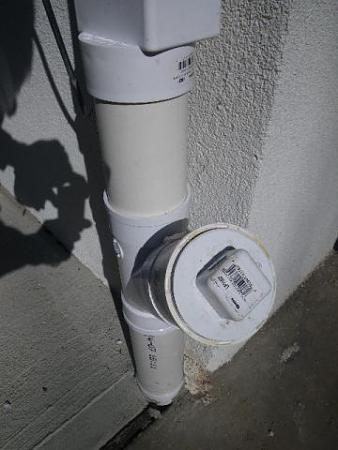
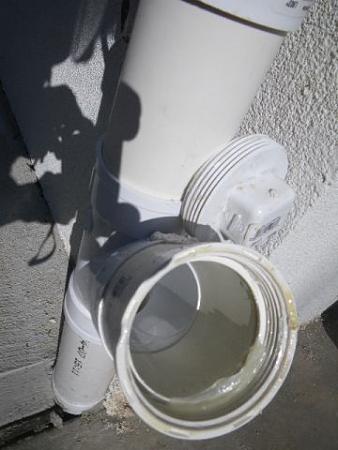
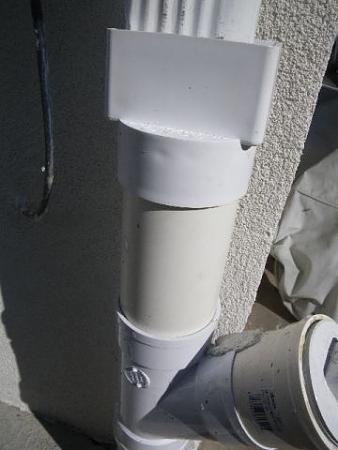
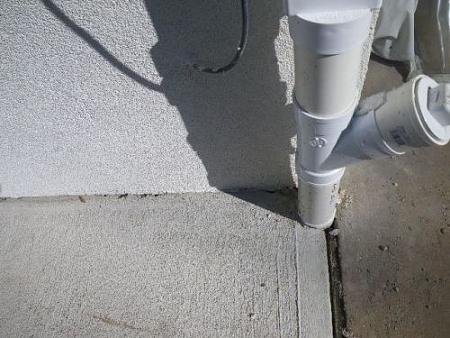
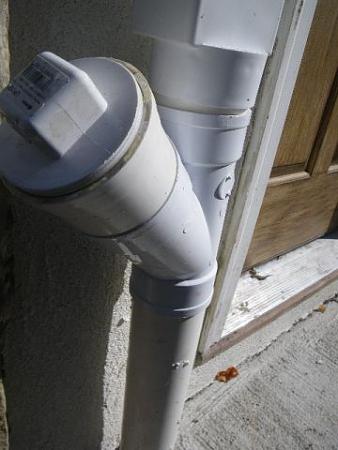
Once you have everything positioned, work from the leaders down to the street.
I put cleanouts in this job which added to the cost. Normally I would be more conservative with materials cost, but here the customer was picky, so I made them happy. 
-
 Underground drain pipe part 3:
Underground drain pipe part 3:
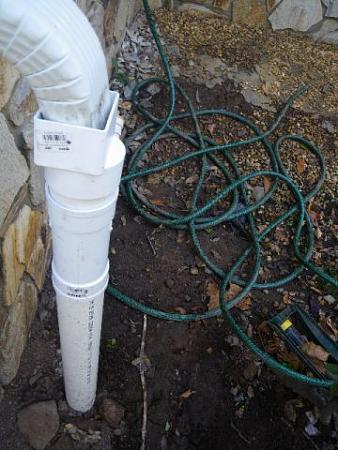

Glue all your pieces, check the run one last time. It's important to cut the curb and sidewalk the right way if you have pitch issues. By that I mean sometimes you have to modify the edge of the pipe where it comes in contact with the curb, especially in older areas where the sidewalk has sunk or they didn't originally make curbing with these drains in mind.
Put it all together and cover up with dirt. You should keep the dirt a little higher in that area to account for sinking in the first week or so.
You may have to build up or make a heightened form for your curb exit for the pipe. Do this professionally with the right wooden forms and people will admire the smooth work. Do it half assed and it will bring negative attention to the job.
This is the best case scenario, perfect pitch and alignment, didn't even have to cut the curb for this side.
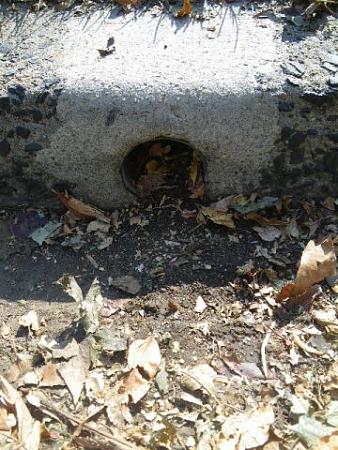
Also in some towns you need a curb cutting permit. Get it to avoid hassles (One more way for the town to rape you) 
Allow enough time for all sidewalk and curb concrete to dry before people can walk on it.
Stand back and admire your work. 
I'll load the pics when I get a chance.
-

In these pics you can see where the drain intersects the curb, it's a lot lower. I needed to "git er done" this way to maintain pitch throughout the whole run. I know eventually the street side will clog up with leaves and debris. That's why I put the cleanout at the beginning of the run.
A perfect fix in this case would have involved raising the sidewalk to the drain tube would come out exactlyh flush with the street. However, to do that would involved busting up 4 perfectly good slabs and adding more time, materials and labor to the job cost. Not worth it when you can solve the problem more easily by putting a cleanout in for $15 extra. 
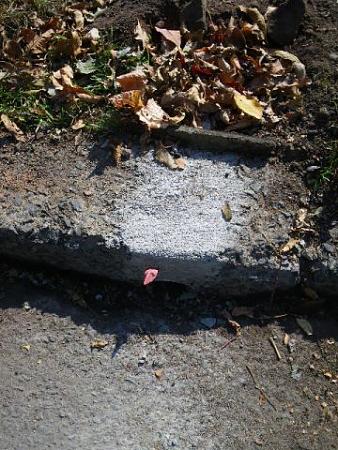
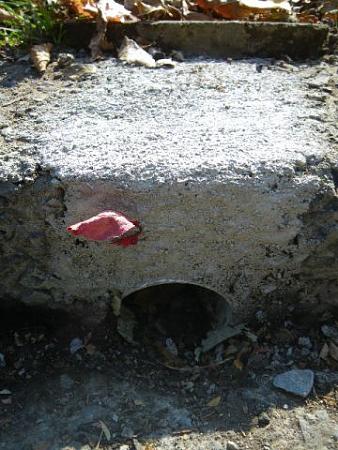
Pic of where I cut and repaired the sidewalk.
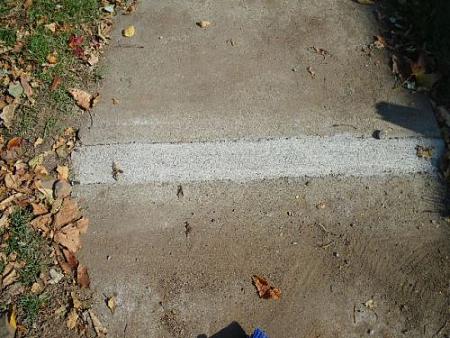
-

This is the area where I ran a "wye" run to connect the right side leader drain to the one from the side of the house and tie it all in to the drain at the curb.
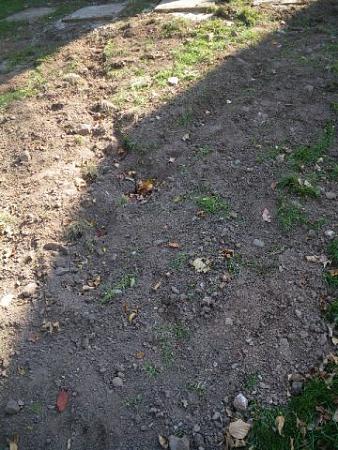
-
 Some more tips to deal with outside groundwater and rainwater
Some more tips to deal with outside groundwater and rainwater
A friend is having water problems.
I sent this to him and thought some others would like to learn...
http://www.askthebuilder.com/B67_Tip...d_Houses.shtml
Many modern building codes have responded to this problem. They require that the top of foundations or slabs be at least 6 inches above the highest point of soil at any location around the house. Furthermore, the ground must fall away from the foundation at least 6 inches within the first 10 feet around the perimeter of the house. Note that this is a minimum requirement. The more slope the better.
In my opinion, you can never have too much slope away from your house. My guess is that anyone who has a wet basement or ground that slopes back towards their foundation will agree.
Existing Construction
Those of us with existing houses that have grade problems face different challenges. Landscaping, sidewalks and other improvements must be dealt with in trying to correct grade problems.
If you are lucky enough to have a sloped lot, your task of establishing grade can be accomplished. It may take a small piece of earth moving equipment like a Bobcat or skid-steer loader, but it will be worth it.
If you have a situation where ground is slopping towards your house (houses built on hillsides), the trick is to slope the ground gently by creating a swale. This swale, or ditch, allows you to do two things. It gets water away from the house and at the same time collects the water which runs downhill towards your house.
*********
More links:
http://www.hammerzone.com/archives/f...ding/slope.htm
There are many causes of foundation leaks. Some repairs can be extremely expensive, some can be quick and cheap. It makes sense to try the cheap-and-easy repairs first, to see if they work, before digging into the heavy stuff.
Basement leak remedies can take two basic forms: 1. Keeping water away from the foundation. 2. Ensuring a water-tight seal all around the foundation.
Generally, solutions that fall into category #1 are easier and cheaper. These could be:
****Make sure the soil is properly graded away from the foundation.
- Deter water from entering the soil next to the house by covering the ground with a water-tight barrier, such as plastic, or soil with a high clay content.
- Escort the water away from the foundation area with a simple system of drain pipes.
- Install rain gutters and ensure that the downspouts are directed well away from the foundation.
The solutions from category #2 would include excavating the soil around the house and:
- Filling any cracks in the foundation with hydraulic (expanding) cement.
- Repairing loose or poorly finished mortar joints in concrete block foundations.
- Coating the foundation with a sealant, such as tar, Thoro-Seal (a cement-based product), or a bituminous membrane like Vycor Ice and Water Shield.
http://www.google.com/#q=how+to+grad...2ea6e12edc6080
 Posting Permissions
Posting Permissions
- You may not post new threads
- You may not post replies
- You may not post attachments
- You may not edit your posts
-
Forum Rules




 Reply With Quote
Reply With Quote





